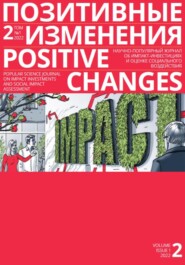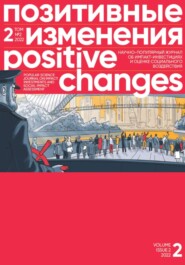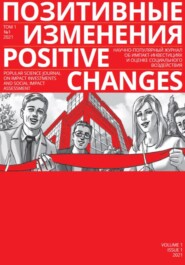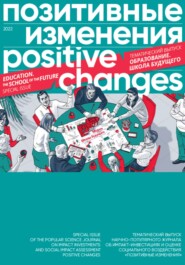По всем вопросам обращайтесь на: info@litportal.ru
(©) 2003-2025.
✖
Позитивные изменения. Города будущего. Тематический выпуск, 2022 / Positive changes. The cities of the future. Special issue, 2022
Настройки чтения
Размер шрифта
Высота строк
Поля
• Dialogue and cooperation are the basic principles of strengthening social linkages. That is, the local community is not a passive beneficiary, but an equal participant and leader in the project.
In order to accumulate expertise in community development with a view on reflective solidarity, that is, the conscious inclusion of different, not necessarily active and resourceful population groups, the Foundation launched a cross-program pilot project Solidarity Communities in 2021. It was based on the best practices and approaches of Cultural Mosaic, while focusing on a different principle of setting up competitive selection and accompanying program.
The primary hypothesis of the pilot project was built around dialogue and collaboration within the community:
Thesis 1: the consolidation of the local community with the participation groups of residents in the same area but with different values and interests is a more effective form of solving local problems than the initiatives of individual activist groups or residents.
By building the pilot project around certain values and concepts, the Foundation expected that its participants would:
• purposefully include representatives of vulnerable groups as project beneficiaries;
• seek to create points of growth in the local economy;
• try to avoid an infrastructural focus and prefer a social focus rather than performing beautification or conducting festivals;
• study the social environment of their territories – surveying residents, discussing their needs and taking them into account in the design and implementation of projects;
• create partnerships with the groups they haven’t worked with before;
• build the projects around the opinions and interests of the majority of residents.
The Foundation selected three regions of the Russian Federation to pilot the project in 2021: Nizhny Novgorod Region, Perm Krai, and Arkhangelsk Region. After analyzing the results, the project concept was expanded to include two more regions – Primorsky Krai and Samara Region. In 2022, the competition became harder for the applicants. They had one more condition to meet – conduct small opinion surveys in their territories and discuss the needs and problems with local residents. At the same time, the focus on involving and including not only a few recognized opinion leaders, but also residents "disengaged" from such activity, including representatives of vulnerable groups living in the territory – was strengthened and included in the requirements for applications and in the evaluation criteria.
The hypothesis was supplemented with a new thesis reflecting the influence of local communities on the economic development of the territory.
Thesis 2: The development of local communities can generate new economic forms of activity in the territory and contribute to its development in the long term.
The pilot stage of the project is still a few months away; the final assessment of the effects will be obtained in February 2023. However, there are a number of conclusions that the Foundation has already made for itself at this stage after working in this direction for almost two years.
1. The closer and clearer the subject matter of the project is to the majority of local residents, the greater response and engagement it generates. In both 2021 and 2022, projects related to area beautification and leisure (sports, culture, tourism) accounted for about 60 % of the total number of winners.
2. The more compact the area, the more engaged residents are, because the ties within the community (social capital) are higher. According to the interviews conducted by the Foundation with the applicants, in small towns and large villages with populations over 1,000 people, project authors claim it is physically impossible to engage the majority of the residents, as there are too many people and no reason for close communication between them.
3. Experienced leaders from NGOs and state-budget institutions find it harder to work with a wide audience from a community perspective, because there is a tradition of acting in the interests of some narrow target group.
4. In rural areas, there is a tradition of caring for some vulnerable groups, sometimes not even recognized as a special form of work. However, it still seems hard to engage the vulnerable groups as co-actors, not beneficiaries.
5. Quickly and simultaneously achieving both parts of the hypothesis – economic points of growth and community consolidation involving vulnerable groups – seems unattainable at the moment. In order to build such a complex construct and change the residents’ behavioral patterns, a longer period of constant work is needed (2–3 years at least).
6. It is possible for the local community to generate economic growth points, but this requires outside support.
In 2021, Solidarity Communities had only two projects aimed at developing the local economy – souvenirs from Kargopol in the Arkhangelsk Region and a pretzel festival in Vladimirskoe village, in the Nizhny Novgorod Region.
In 2022, there are already six such projects. The Arkhangelsk Region is the leader, with four projects (Vlasyevskaya, Erkino, Solvychegodsk, Ust-Pocha); the Perm Krai (Lysva) and the Samara Oblast (Avgustovka) follow with one project each.
JUSTIFICATION OF THE VLASYEVSKAYA VILLAGE APPLICATION
"There are no jobs in the village, no store, no club, no post office. Our project aims to give the inhabitants of our village the opportunity to realize themselves in handicrafts, to share their knowledge and skills with each other, to teach them the techniques and opportunities for selling their products. And finally, to help them see an opportunity of making extra income from the sale of handmade goods."
"Economic" projects carried out within the framework of Solidarity Communities cannot yet claim to be drivers of territorial development. But they do have a few things in common:
• These are the projects run by enthusiasts, amateurs in the field of business;
• Above all, the projects lack planning – not only the prospects are omitted from of the applications, they are not even visualized. These are experiments;
• It is noteworthy that none of the projects, except for the Ust-Pocha application, are oriented toward external markets. Participants intentionally separate themselves from the general audience.
But with proper development and support, they can become more effective.
EPILOGUE
Territory development is a complex concept. It includes economic indicators, social activity of the residents, and availability of infrastructure elements (rural health posts, schools, roads, etc.). Of course, in a broad sense, it is impossible to develop a territory based solely on the actions and resources of activists and the ABCD approach. But they can set this process in motion, turning a depressing and dreary territory into something completely different.
According to the Living Cities national initiative, 1 % of the population of any territory are change leaders. Those with the power to initiate and guide the actions of the people around them, for the good or otherwise. For all the diversity and inconsistency of theoretical and practical approaches to community concepts, the actions of these individuals – indifferent, compassionate, persistent, and good-natured – are evident all over the country, in a variety of spheres.
They create "telephone chains," helping lonely elderly ladies regain or rebuild their social circle and avoid social isolation.
They collect the stories of their grandparents and create the Forgotten Villages Museum.
They help parents of children with disabilities get at least a little rest and support, organize wheelchair-accessible events or performances that can be watched in total darkness on an equal footing with others.
They help teenagers find their place in the city by working with them to build demo versions of the spaces they dream of using nothing but cardboard boxes and bags. Eventually, those spaces materialize in real life.
Communities can be different, some are just emerging, others have been around for decades. These could be urban apartment building / yard chats: or a village-wide chat of 108 people. These can be associations of professionals and leaders in the field or just a company of old friends, helping shelters out of pure kindness, or sorting garbage because of their personal beliefs.
As the Foundation’s extensive experience shows: in order to change the world for the better, you just have to start acting.
The author is grateful for the help in creating this material to the following outstanding individuals: Maria Morozova, Irina Kalistratova, Tamara Slavinskaya, Ivan Tarasov, Dmitry Lisitsin, Peter Ivanov, Elena Serebrennikova, Veronika Suvorova, Dmitry Mashin, Anna Kuznetsova.
Исследования / Research Studies
Насколько устарело наше будущее? Гипотезы об изменениях приоритетов муниципального управления
Образ будущего не является чем-то постоянным. Особенно это очевидно в наши дни, в России, когда за последний год условия развития городов кардинально изменились. Тем более важно наблюдать изменения и делать выводы в текущем моменте – когда происходят тектонические сдвиги во всех сферах жизни и деятельности общества. Анализу и фиксации такого «момента» в пространстве муниципального управления посвящено исследование, проведенное Школой Управления СКОЛКОВО.
Алексей Гусев
Директор по аналитике в государственном секторе Школы Управления СКОЛКОВО
Виталий Кунашко
Аналитик Школы Управления СКОЛКОВО
Осенью 2021 года мы в Школе Управления СКОЛКОВО завершили программу обучения команд 100 крупнейших городов России, это была самая масштабная в стране программа подготовки управленцев для муниципального уровня. Мэры городов в присутствии губернаторов и руководителей федеральных агентств «защищали» проекты в области устойчивого развития, новых отраслей экономики, инфраструктуры и благоустройства. Эти проекты – «слепок» того образа будущего, которое нам вместе с городскими командами удалось сформировать в результате долгой и часто непростой работы.
С того момента прошел ровно год и за этот период внешний контекст поменялся так радикально, как никто не мог себе представить. Метафорически выражаясь, наше видение будущего успело несколько раз устареть. Поэтому, проектируя новую программу для городских команд, мы решили провести помимо формального мониторинга прошлогодних проектов дополнительное миниисследование – серию интервью с мэрами и другими участниками прошлогодней программы. В выборке интервью были города из Центрального, Поволжского и Уральского округов, областные центра, малые и средние города. Разумеется, 10 глав муниципалитетов нельзя назвать репрезентативной выборкой, поэтому в рамках этого текста мы сформулируем несколько исследовательских гипотез, которые только предстоит проверить в рамках продолжения нашего исследования, а также непосредственно в динамичном общественном процессе. Кажется важным зафиксировать эти гипотезы как «отпечаток» нового времени – контрольную точку, на которую мы сможем оглянуться из будущего, чтобы сверить свои прогнозы.
ГИПОТЕЗА 1: НА УРОВНЕ МУНИЦИПАЛЬНОЙ БЮРОКРАТИИ ПОВЕСТКА РАЗВИТИЯ ЗАМЕЩАЕТСЯ ПОВЕСТКОЙ СОХРАНЕНИЯ СТАБИЛЬНОСТИ









